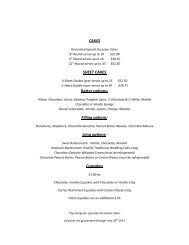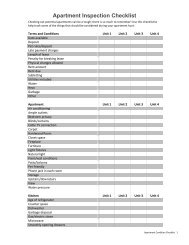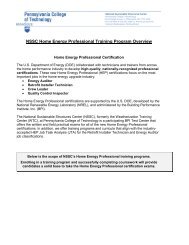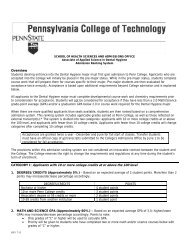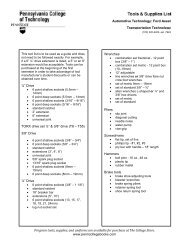Winter 2008-09 - Pennsylvania College of Technology
Winter 2008-09 - Pennsylvania College of Technology
Winter 2008-09 - Pennsylvania College of Technology
- TAGS
- pennsylvania
- pct.edu
Create successful ePaper yourself
Turn your PDF publications into a flip-book with our unique Google optimized e-Paper software.
tension builds, and guess what happens next?<br />
Keeping the hamstrings pliable is a priority<br />
for keeping the low back safe.<br />
You don’t need to buy the yoga video and<br />
try to pretzel yourself daily for 45 minutes.<br />
It would be wonderful if you had the time.<br />
People who practice yoga regularly are more<br />
fluid than the rest <strong>of</strong> us. Even twice a week<br />
would begin to erase the stiffness we carry as<br />
if it were the norm. But, a few minutes daily<br />
can make a difference and possibly prevent<br />
that back spasm.<br />
Stretching for flexibility takes about 30<br />
seconds for each major joint. Again, you<br />
don’t need to purchase much, if anything at<br />
all. With each stretch, breathe slowly about<br />
six times. You’ll find that takes about a halfminute.<br />
The stretch is held just at the point<br />
<strong>of</strong> tightness, not into the pain. Your body,<br />
amazing as it is, has a protective mechanism<br />
called the stretch reflex. Push that stretch<br />
too far, and it will tighten to prevent a tear. If<br />
you stick with it, you will find that point <strong>of</strong><br />
tightness will be further and further into the<br />
joint’s range <strong>of</strong> motion.<br />
The simplest way to stretch hamstrings<br />
is to put one leg up on a chair, stool or any<br />
immovable object that is as high as your<br />
standing knee. Flex over with your upper<br />
body in good posture until you feel that pull.<br />
Breathe. Repeat right and left leg twice.<br />
BODY COMPOSITION<br />
Body composition is the distribution <strong>of</strong><br />
your body weight: fat-free mass and fat mass.<br />
Your FFM is the weight <strong>of</strong> everything you<br />
are made <strong>of</strong> except your fat. Your fat mass<br />
can be at the level <strong>of</strong> an athlete, way too little<br />
and, for most <strong>of</strong> us, way too much. With<br />
winter upon us, the fight gets a bit tougher.<br />
We are less active. We wear more clothes.<br />
We eat more food.<br />
When you are home on a cold, nasty<br />
day, what’s there to do? Nibble here, snack<br />
there, sit and read or catch a couple <strong>of</strong> “Law<br />
& Order” reruns? It might be earned after<br />
an exhausting week, but even finding 30<br />
minutes <strong>of</strong> constant movement will rev up<br />
your metabolism for a while, lubricate the<br />
joints, release some feel-good hormones and<br />
deliver oxygenated blood to your muscles.<br />
And, you will be proud <strong>of</strong> yourself. You<br />
made an effort. You succeeded.<br />
Getting outside is the better choice<br />
(weather permitting). Fresh air and sunshine<br />
are the Godiva for your cells. Layer yourself<br />
with warmth and take a walk. If that is<br />
not possible, then look around. Bi level<br />
home? Use the stairs and complete two or<br />
three laps. Do this a few times during the<br />
day. One-level house? Time yourself and<br />
just walk through the rooms for five to 10<br />
minutes a few times a day. Find a chair (no,<br />
not the recliner), sit/stand for 10 repetitions<br />
and walk away. Come back in two minutes<br />
and do it again. Easy, simple and done in less<br />
than four minutes!<br />
You don’t need a whole gym in your<br />
basement or <strong>of</strong>fice. You just need your brain<br />
to engage your muscles to move your bones,<br />
which requires your heart to deliver more<br />
blood, and a little creativity. Carrying too<br />
much FM is not only uncomfortable and<br />
discouraging but unsafe. Obesity is now the<br />
second-most preventable risk factor for heart<br />
disease. A few pounds gained here and there<br />
add up, and before we know it … “What size<br />
is that?”<br />
Now is the time we make those promises<br />
to ourselves with the best intentions. During<br />
this cold-weather season, it is more difficult<br />
to find the dedication to keep them. So, don’t<br />
be ridiculous. Small, incremental goals are<br />
reachable and therefore motivational. And<br />
the upward cycle continues. Hang in there,<br />
the sun is on its way back. Any day now. ■<br />
Web Extra<br />
additional content at<br />
www.pct.edu/oca<br />
upper-back<br />
stretches<br />
hamstring/low-back<br />
stretches (standing)<br />
chest stretches<br />
hamstring/low-back<br />
stretches (lying)<br />
<strong>Winter</strong> <strong>2008</strong>-<strong>09</strong> 7




